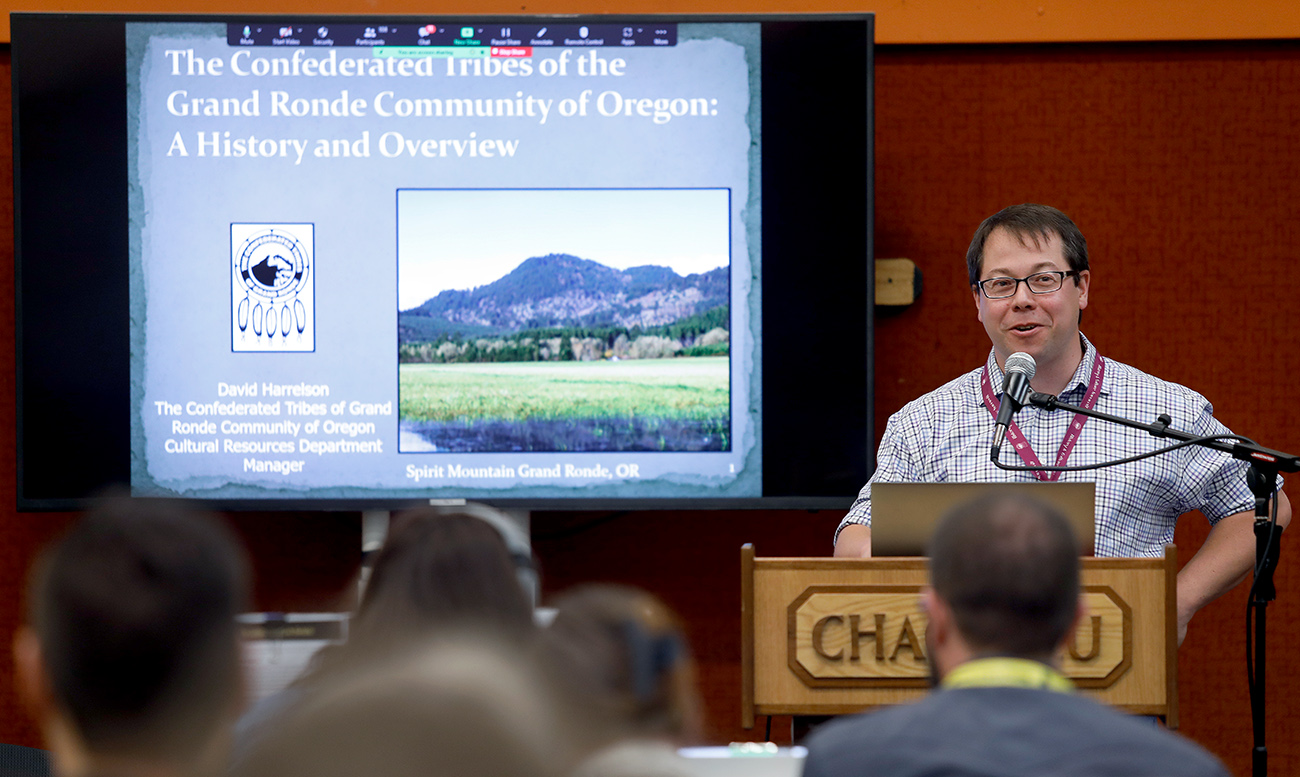Culture
History and Culture Summit returns

By Danielle Harrison
Smoke Signals editor
After a five-year hiatus, the Grand Ronde History and Culture Summit returned to an in-person format.
Hosted at Chachalu Tribal Museum & Cultural Center on Wednesday and Thursday, Oct. 4-5, the summit’s theme was “Reconnecting People, Place and Past,” and it featured presentations about Grand Ronde history, culture and current projects, and was organized around each of the Tribe’s treaty areas. The summit is presented by the Tribe’s Cultural Resources Department.
Cultural Resources Department Manager David Harrelson welcomed attendees to the Chachalu gym Wednesday. After making a few jokes about the orange shag carpet adorning the gym’s walls, he told them the summit began as a means to help remedy that the histories of Oregon’s Tribes had not been properly documented.
“I’m so glad you’re all here,” he said. “The collective brain trust in this room is impressive. … We started the History and Culture Summit about 10 years ago as a direct response to the Tribe working with scholars. Our history existed in reports, but no one had access to it.”
Harrelson further explained that the summit highlights the Tribe's relationships, places and practices throughout its ceded lands.
Approximately 175 people attended in person, with approximately 150-plus utilizing the virtual Zoom format.
Those in attendance included community, staff and Tribal members, as well as representatives from other Oregon Tribes and various city, state and federal agencies. Also in attendance were Tribal Council members Kathleen George and Jon A. George, and former longtime Tribal Council member Reyn Leno.
“It was a wonderful turnout and really full house,” Kathleen George said at a Legislative Action Committee meeting on Tuesday, Oct. 10. “Everyone enjoyed the sharing of wonderful Grand Ronde culture and history. This is viewed as a very valuable event by many agencies throughout the Northwest.”
The summit began with drumming and singing, led by Harrelson, Cultural Advisor Bobby Mercier and Cultural Education Coordinator Jordan Mercier. Jon A. George gave the invocation.
Morning presentations included an overview of Grand Ronde by Harrelson, telling the story of place by Tribal Communications Director Sara Thompson and Willamette Valley traditional use areas by Cultural Policy Analyst Greg Archuleta.
“We say we have been here since time immemorial, which literally means since a time that no one can remember,” Harrelson said. “Yet, implicit in that is that we remember the floods. Not only do we remember the floods, but our ancestors in the late 1800s and early 1900s remembered it too, and shared those stories, well before the theory of the Missoula Floods in the 1980s.”
Scientists date the Missoula Floods, which cut a swath through what is now the Columbia River Gorge and Willamette Valley, at the end of the last ice age 15,000 to 18,000 years ago. Tribal oral traditions include stories of people escaping by running up a mountain to get away from a giant flood, and that the water moved slowly enough so that they could get to safety.
“Those stories all match that the water slowly backed up in the Willamette Valley, filling it with water,” Harrelson said. “So when we say we have been here since time immemorial, it is at least before the floods.”
Harrelson also discussed the various treaties signed with Grand Ronde ancestors, who belonged to some 27 Tribes and bands across Oregon, and how they were eventually forced onto what is now the Grand Ronde Reservation. He also touched on the Termination era, Restoration and current culture and events.
“We’ve going to be celebrating our 40th Restoration, and now we’ve been restored longer than we’ve been terminated, which is a pretty powerful time to be living, but we’re still working on everything,” Harrelson said.
Thompson gave an overview of the 10-video “Honoring Our Homelands,” project the Tribe’s Communication Department is producing, with the goal of taking people to areas of the homelands they may never get to experience in person. She also showed a video to attendees featuring Tribal Council Vice Chair Chris Mercier hiking near obsidian cliffs.
“In those stories of place, they do a number of things,” Thompson said. “They ground us to our ikanum (traditional stories), they teach us how these places were created and what they were created for. Place tells us who we are and where we are from, and about a landscape that has always supported us.”
The first day of the summit included several breakout sessions, such as a visit to the former Grand Ronde governance and cannery sites, fire panel discussion, information about the Indigenous Placekeeping Artist Fellowship and guided museum tours. The afternoon featured lectures on the Columbia River traditional use areas, using maps for restoration, multispectral imaging and the Grand Ronde’s recently expanded hunting and fishing rights.
The day ended with an optional dinner of salmon, elk chili, cornbread, salad and berry cobbler at the Tribal plankhouse.
Thursday’s presentations included information regarding oral history at Grand Ronde, Southern Oregon traditional use areas, the Rattlesnake Butte burn study, Indigenous garden networks, archeology of the Seaside area and more.
The summit concluded at noon Thursday and attendees were given a boxed lunch to take home with them.
The summit is an annual event hosted by the Cultural Resources Department since 2013. However, it was paused in 2020 due to the COVID-19 pandemic. The last in-person gathering was in 2019 at Chachalu, and was focused on Chinookan art, with a collaborative carving project by several artists and hands-on activities for attendees.
In 2020, like virtually every large indoor gathering, the Tribe’s annual History and Cultural Summit was presented via Zoom.
